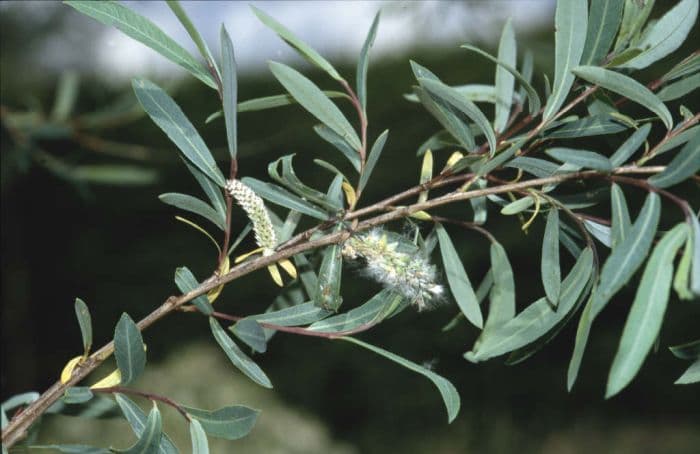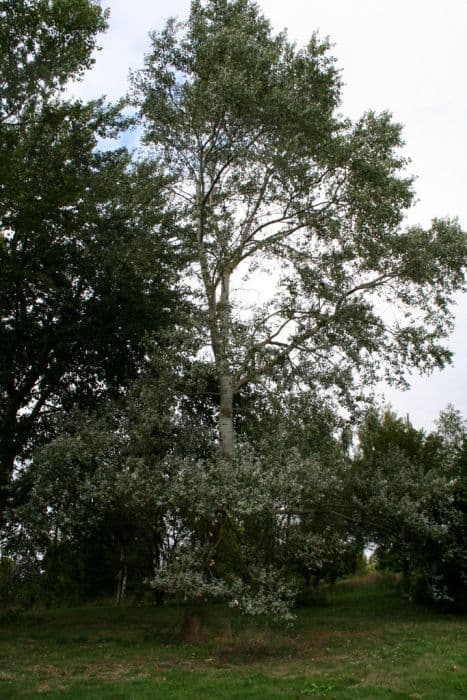Purple Willow Salix purpurea

ABOUT
The plant commonly known as the purple willow or purple osier, is best recognized for its strikingly colored stems and lush foliage. The stems often exhibit a beautiful purple or reddish hue, which is particularly vivid during the winter months, making it stand out in contrasting snowy or dormant landscapes. Its leaves are elongated, with a slender and narrow shape, typically showcasing a blue-green tint on the upper side while the underside might appear lighter, sometimes with a whitish or silvery sheen. As the seasons change, the purple willow produces catkins, these floral structures are quite prominent and appear before the leaves fully emerge in spring. The catkins of purple willow are usually a mix of silver, yellow, and red hues, adding to the ornamental quality of the plant during its blooming period. The flowers are notable for their appeal to pollinators, often bustling with bees and other insects when in bloom. In terms of its overall form, the purple willow tends to exhibit a bushy, branching habit with a dense canopy of leaves, providing a lush, full appearance. Its bark is typically rough and contributes to the textural interest of the plant throughout the year. The foliage tends to rustle pleasantly in the wind, adding an auditory as well as a visual appeal to the landscape.
About this plant
 Names
NamesFamily
Salicaceae
Synonyms
Purple Osier, Purple Willow, Basket Willow
Common names
Salix purpurea var. lambertiana, Salix daphnoides var. purpurea, Salix purpurea var. angustior, Salix purpurea var. gracilis, Salix purpurea var. pendulina, Salix purpurea var. sericea.
 Toxicity
ToxicityTo humans
Purple willow (Salix purpurea) is not typically known as a toxic plant to humans. However, as with many plants, individual allergies or sensitivities can occur, which might cause mild reactions. There are no well-documented symptoms of poisoning in humans resulting from ingesting purple willow. It's always recommended to practice caution and avoid consuming parts of any plants not generally recognized as edible, as individual reactions can vary.
To pets
Purple willow (Salix purpurea) is generally considered to be non-toxic to pets such as dogs and cats. It does not contain known compounds that are poisonous to these animals. However, ingestion of a large amount of plant material may result in gastrointestinal upset, as with any non-food plant matter. If your pet consumes purple willow and shows signs of distress, it is advisable to consult a veterinarian.
 Characteristics
CharacteristicsLife cycle
Perennials
Foliage type
Deciduous
Color of leaves
Green
Flower color
Yellow
Height
3-15 feet [0.9-4.6 meters]
Spread
3-15 feet [0.9-4.6 meters]
Plant type
Shrub
Hardiness zones
4-8
Native area
Europe Asia
Benefits
 General Benefits
General Benefits- Erosion Control: Salix purpurea has extensive root systems that stabilize soil and prevent erosion along riverbanks and in wet areas.
- Wildlife Habitat: Provides shelter and nesting sites for birds as well as a food source for caterpillars and herbivorous animals.
- Ornamental Value: Valued for its decorative purposes in gardens and landscapes due to its colorful stems and graceful form.
- Windbreak: Often planted in rows to act as windbreaks that protect crops, soil, and buildings from harsh winds.
- Streambank Stabilization: Commonly used in riparian plantings to stabilize streambanks and reduce sedimentation in waterways.
- Soil Reclamation: Can be used to restore or improve degraded soils with its tolerance to heavy metals and soil contaminants.
- Biomass Production: Grows quickly and produces a high yield of biomass, which can be used for fuel, fiber, or as a raw material in various industries.
- Phytoremediation: Known for its ability to take up and accumulate heavy metals from the soil, making it useful in cleaning up polluted sites.
- Biodiversity Support: Contributes to the biodiversity of an area by supporting various insect and plant species within its ecosystem.
- Live Fencing: Can be used to create living fences or barriers, which are more sustainable and eco-friendly than manufactured fencing materials.
- Crafting and Weaving: The flexible stems are traditionally used for basketry and crafting, providing materials for artisanal crafts.
 Medical Properties
Medical Properties- Anti-inflammatory: Salix purpurea, commonly known as purple willow, contains salicin, a compound that when metabolized by the body, can act as an anti-inflammatory agent.
- Analgesic: The salicin in purple willow also has pain-relieving properties similar to aspirin.
- Antipyretic: Traditionally, preparations of this plant have been used to reduce fever due to its salicin content.
- Astringent: The tannins present in purple willow bark can provide astringent effects, which might be helpful in treating gastrointestinal issues like diarrhea.
 Air-purifying Qualities
Air-purifying QualitiesThis plant is not specifically known for air purifying qualities.
 Other Uses
Other Uses- Salix purpurea, commonly known as purpleosier willow, has been used in the creation of musical instruments, particularly flutes and whistles, where its wood is valued for its fine grain and workability.
- The flexible branches of the purpleosier willow are traditionally used for basket weaving, providing material for intricate and durable wickerwork.
- Purpleosier willow's twigs can be harvested for the craft of traditional willow structure building, such as living willow sculptures and playhouses that can grow and green in place.
- The wood of the purpleosier willow serves as a natural source of high-quality charcoal used by artists for drawing and sketching.
- Purpleosier willow's bark has been historically used for tanning leather due to the presence of tannins, which provide color and preserve the leather material.
- This plant's lightweight and strong wood are used in the manufacture of cricket bats, favored for its shock-absorbing properties.
- Purpleosier willow branches are used in the practice of coppicing, a traditional method of woodland management that produces a sustainable supply of wood.
- The wood is sometimes used for making rustic furniture, harnessing its flexibility and durability for creating unique outdoor pieces.
- Purpleosier willow is also popular as a source of biofuel, particularly in biomass plantations, due to its fast growth rate and high calorific content of the wood.
- In a niche crafting technique known as marquetry, the fine-grain wood of Salix purpurea is used for creating detailed inlays on wooden surfaces and furniture.
Interesting Facts
 Feng Shui
Feng ShuiPurple Willow is not used in Feng Shui practice.
 Zodiac Sign Compitability
Zodiac Sign CompitabilityPurple Willow is not used in astrology practice.
 Plant Symbolism
Plant Symbolism- Flexibility: Salix purpurea, commonly known as Purple Willow, is known for its flexible branches, which symbolize adaptability and resilience, suggesting the ability to thrive in various conditions and bend without breaking.
- Grief: In some traditions, willows are associated with sorrow and mourning, possibly because of their drooping branches that can appear to be weeping, making Purple Willow a symbol for loss and the expression of grief.
- Healing: Historically, the willow family has been associated with healing due to the presence of salicylic acid in their bark, which was used to make pain-relieving medicine. This lends the Purple Willow a symbolic meaning of healing and relief.
- Inner Vision: Due to its connection with water and the moon, which are symbols of intuition, Purple Willow represents inner vision, and a deeper understanding of the self and the world.
- Growth: The rapid growth of willow trees symbolizes the ability for personal expansion and growth, hence Purple Willow can symbolize the quick adaptability and potential for change in a person's life.
 Water
WaterThe Purple Willow (Salix purpurea) prefers consistently moist soil and should be watered deeply to encourage root growth, particularly in dry conditions. Water the plant once or twice a week, depending on weather conditions, with approximately 1 to 2 gallons of water per instance for young plants, increasing to 3 to 4 gallons for established trees. During hot, dry periods, it may require more frequent watering to maintain soil moisture. Monitor the soil moisture level to ensure it doesn't become waterlogged, as good drainage is essential to prevent root rot. Reduce watering frequency in the winter when the tree is dormant.
 Light
LightThe Purple Willow thrives in full sunlight, which means it should receive at least 6 hours of direct sunlight each day. The best spot is an open area where it can get unfiltered sunlight throughout the day. While it can tolerate partial shade, particularly in hotter climates, optimal growth and form are achieved in full sun.
 Temperature
TemperaturePurple Willow performs well in a wide range of temperatures but grows best when the temperature is between 45 and 75 degrees Fahrenheit. It can withstand colder climates and survive temperatures down to -20 degrees Fahrenheit, but growth may be stunted below this threshold. Protecting it from extreme heat and ensuring adequate water during hot spells will help maintain its health.
 Pruning
PruningPruning the Purple Willow is necessary to maintain its shape, remove dead or diseased branches, and encourage healthy growth. The best time to prune is in late winter or early spring before new leaves emerge. Prune moderately, up to once a year, focusing on thinning out crowded branches and shaping the canopy. Remove any damaged or broken limbs as soon as they are noticed to prevent disease.
 Cleaning
CleaningNot needed
 Soil
SoilPurple Willow thrives best in a soil mix that is rich, moist, and well-draining. An ideal soil pH for Purple Willow would be in the range of 5.5 to 7.0. Incorporating organic matter such as peat or compost will enrich the soil and provide a good growing medium.
 Repotting
RepottingPurple Willow trees, due to their eventual large size, are not commonly repotted. Instead, they are typically planted directly in the ground where they can spread out. If you must repot, do so in the spring, every 3 to 5 years, or when the tree becomes root-bound.
 Humidity & Misting
Humidity & MistingPurple Willow prefers high humidity levels but is adaptable to average outdoor humidity conditions. It does not require specific humidity control when planted in its natural outdoor environment.
 Suitable locations
Suitable locationsIndoor
Purple Willow is large and better suited outdoors.
Outdoor
Plant in moist soil and full sun to partial shade.
Hardiness zone
4-8 USDA
 Life cycle
Life cycleSalix purpurea, commonly known as purple willow, begins its life cycle when seeds are dispersed by wind or water in the spring. These seeds require moist soil to germinate rapidly and often do so in riparian zones, or areas adjacent to streams and rivers. Once germination occurs, the seedling grows into a young plant, establishing a root system and producing shoots that develop into stems and leaves, with growth being rapid due to its pioneering nature. As the purple willow matures, it develops flowers in the form of catkins, which are typically pollinated by insects, leading to the formation of seeds encased in capsules. After pollination and seed set, the capsules open to release the seeds to start a new generation. Throughout its lifecycle, the purple willow can also propagate vegetatively from cuttings or broken stems, which root easily in moist soil, thus ensuring its spread and survival in suitable habitats.
 Propogation
PropogationPropogation time
Spring
The most popular method of propagating Salix purpurea, commonly known as Purple Willow, is by hardwood cuttings. This is typically done in late fall, after the leaves have dropped, or in late winter, before new growth starts. To propagate, healthy, straight shoots from the current or previous year's growth are selected and cut into sections approximately 6 to 12 inches (15 to 30 centimeters) long. Each cutting should have at least a couple of buds. The cuttings are then inserted into prepared soil or potting mix so that at least two-thirds of their length is underground, ensuring that the buds face upwards. The soil should be kept moist to encourage rooting, which typically occurs within a few weeks, depending upon the environmental conditions. This straightforward technique can yield a high success rate with minimal effort.









